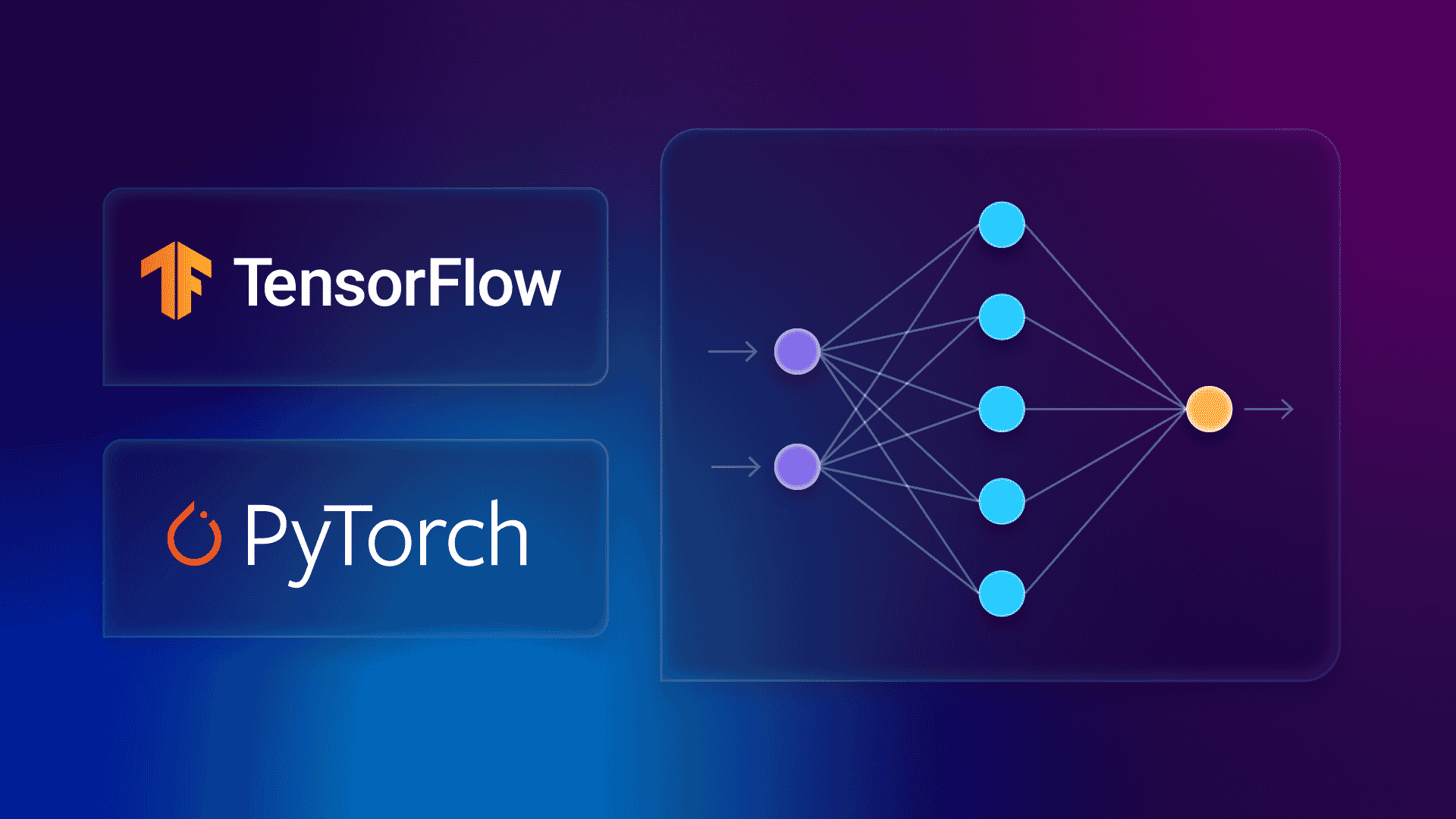Table of Contents
When it comes to AI development, choosing the right deep learning framework can have a significant impact on your project’s speed, scalability, and development ease. TensorFlow and PyTorch are the two most widely used frameworks in the field today, each with its own strengths, user base, and ideal use cases. Both have robust tools for building and training machine learning models, but their differences make them suited to different types of developers and projects.
In this article, we will explore the key features of TensorFlow and PyTorch, compare their performance and usability, and help you decide which framework might be the best choice for your AI development needs.
TensorFlow Overview
TensorFlow, developed by Google Brain and released in 2015, is an open-source deep learning framework designed for building and deploying machine learning models at scale. TensorFlow is well-known for its flexibility, scalability, and broad ecosystem that includes tools for both beginners and advanced users.
Key Features:
- Ecosystem: TensorFlow comes with a broad range of tools, such as TensorFlow Extended (TFX) for productionizing ML workflows and TensorFlow Lite for mobile and IoT deployments.
- Scalability: TensorFlow excels at training models across multiple GPUs, TPUs, and distributed computing environments, making it ideal for large-scale projects.
- High-Level API: Keras, the high-level API integrated with TensorFlow, makes it easier to build and train models using simplified, intuitive syntax.
- Production-Ready: TensorFlow’s mature tooling (like TensorFlow Serving and TensorFlow Hub) supports production deployment and scalability in enterprise environments.
Example (Building a Neural Network in TensorFlow with Keras)
Advantages:
- Production-Ready: TensorFlow is known for its production capabilities, offering tools like TensorFlow Serving for deploying models and TensorFlow Extended (TFX) for end-to-end workflows.
- Cross-Platform: TensorFlow supports deployment on mobile (via TensorFlow Lite), web (via TensorFlow.js), and cloud.
- Community and Ecosystem: TensorFlow has a large, active community and extensive documentation, making it easier to find tutorials, libraries, and support.
Before you look into disadvantages of Tensorflow, I recommend you watching this video with Nicholas Renotte.
Disadvantages:
- Steep Learning Curve: TensorFlow’s flexibility can be overwhelming for beginners. While Keras simplifies many tasks, more complex workflows in TensorFlow require a deep understanding of the framework’s architecture.
- Debugging: TensorFlow’s static computation graph (in versions prior to TensorFlow 2.0) made debugging more difficult compared to PyTorch’s dynamic graph.
PyTorch Overview
PyTorch, developed by Facebook’s AI Research Lab (FAIR) and released in 2016, is another popular open-source deep learning framework. Known for its simplicity and dynamic computation graph, PyTorch is favored by researchers and developers who want a more intuitive and flexible approach to building AI models.
Key Features:
- Dynamic Computation Graph: PyTorch uses a dynamic graph, which means computations are defined at runtime, making debugging and experimentation easier.
- Pythonic: PyTorch’s API feels more natural to Python developers, enabling quick prototyping and easier debugging using tools like PDB or Python’s native debugger.
- TorchScript: Allows models written in PyTorch to be converted to production-ready, optimized code without leaving the PyTorch ecosystem.
- Distributed Training: PyTorch supports distributed training across GPUs and nodes, though it requires more manual configuration compared to TensorFlow.
Example (Building a Neural Network in PyTorch)
Advantages:
- Flexibility: PyTorch’s dynamic graph allows for more intuitive debugging, making it a favorite for researchers and those experimenting with new model architectures.
- Debugging: Since the graph is defined at runtime, debugging is simpler and more natural for Python developers.
- Community in Research: PyTorch is the go-to framework for many researchers and academics, making it the preferred choice for rapid experimentation.
Before you look into disadvantages of Pytorch, I recommend you watching this video from Pytorch.
Disadvantages:
- Production Deployment: While TorchScript helps with deployment, PyTorch is traditionally seen as more suited for research, and TensorFlow is often favored in production environments.
- Smaller Ecosystem: Compared to TensorFlow, PyTorch has a smaller ecosystem of production tools and integrations, although it’s growing rapidly.
Comparison: TensorFlow vs. PyTorch
| Feature | TensorFlow | PyTorch |
|---|---|---|
| Ease of Use | Steep learning curve but Keras simplifies | More intuitive, especially for Python developers |
| Computation Graph | Static (TF 1.x), Eager execution (TF 2.x) | Dynamic graph—defined at runtime |
| Production Deployment | Excellent with TensorFlow Serving, TF Lite, and TFX | TorchScript helps, but more manual for production |
| Ecosystem | Large ecosystem with tools like TensorFlow Extended (TFX), TF Hub, TF Serving | Smaller ecosystem but growing rapidly |
| Debugging | Harder with static graphs, better with TF 2.0 | Easier due to dynamic computation graph |
| GPU/TPU Support | Excellent support, especially with TPUs | Supports distributed training, but configuration is more manual |
| Community | Large and well-established, with many production use cases | Strong research-focused community, growing in production |
Which Framework Should You Choose?
When to Choose TensorFlow:
- Production-Ready: If your focus is on deploying models at scale in a production environment, TensorFlow is a strong choice due to its robust ecosystem, including tools like TensorFlow Serving, TensorFlow Lite, and TensorFlow Extended (TFX) for end-to-end workflows.
- Cross-Platform Deployment: TensorFlow’s support for deploying models on mobile, web, and edge devices makes it ideal if your application spans multiple platforms.
- Large-Scale Projects: TensorFlow’s scalability with multiple GPUs, TPUs, and distributed computing environments makes it a good option for large-scale, complex projects that need robust infrastructure.
When to Choose PyTorch:
- Research and Experimentation: If you’re working in academia or conducting cutting-edge research, PyTorch’s flexibility, dynamic computation graph, and ease of debugging make it ideal for rapid experimentation and prototyping.
- Pythonic Development: PyTorch’s API is intuitive for Python developers, making it easier for teams already comfortable with Python to adapt quickly.
- Smaller Teams: PyTorch is a good option for smaller teams or startups where the focus is on quick iteration and experimentation, rather than large-scale production deployments.
Conclusion
Both TensorFlow and PyTorch are powerful tools for AI development, but the right choice depends on your specific needs. TensorFlow shines in production environments with its scalability, wide toolset, and support for deployment across platforms. On the other hand, PyTorch is favored by researchers and developers for its flexibility, ease of use, and dynamic graph, which make it perfect for experimenting with new models and architectures.
For production-oriented enterprises, TensorFlow remains the go-to framework, while PyTorch is becoming increasingly popular in research and rapidly gaining traction in production due to improvements in tools like TorchScript.
Julia Knight
Tech Visionary and Industry Storyteller
Read also
November 19, 2024
November 19, 2024
November 19, 2024

